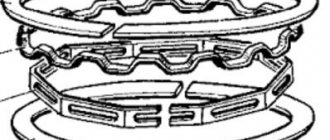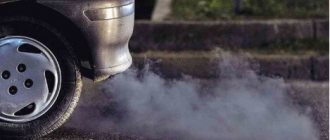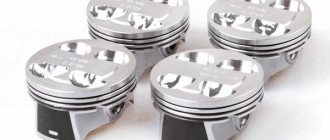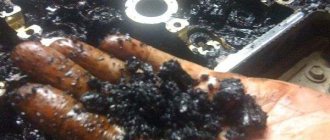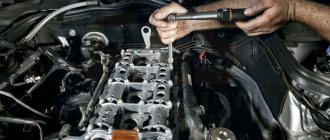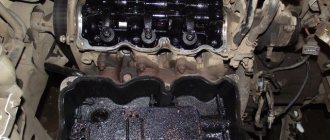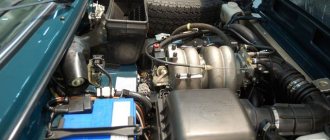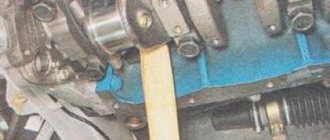When an engine is being repaired, car owners often ask what clearance should be on the piston rings. This question breaks down into two separate ones. For both compression and oil control piston rings, two parameters are standardized - the vertical (axial) gap and the gap size in the lock. Both parameters must be within certain limits, but we note right away that too much axial clearance, as well as excessive clearance in the lock, is nothing compared to what will happen if you install a ring with very small end clearance. In the latter case, of course, we were talking about the gap in the lock - it is otherwise called “end”, and we must talk about this value in more detail.
Why are there three rings on the piston?
The two upper rings, installed in the piston grooves, are needed to maintain compression. In the figure, these elements are indicated by the numbers “1” and “2”. And the lower ring, designated as “3”, is an oil scraper ring:
Less than 3 rings on the piston are not used in 4-stroke internal combustion engines
When the engine is running, the parts heat up, the metal expands due to heating, and the size of all gaps decreases. If the gap between the ends of the ring is smaller than recommended by the manufacturer, then after warming up such a ring will scratch the cylinder walls. Measurements must be taken without heating the part, and the ring itself must be placed in the cylinder:
Gap measurement cannot be performed without access to the cylinder block
To find out the size of the gap, use special probes (bars). Typically recommended values are in the following range: 0.2-0.5 mm. Still, be sure to check the documentation!
Everyone knows what gap is recommended for VAZ engines: on piston rings that create compression, it should be 0.25-0.4 mm (not less than 0.25 mm). Other values are suitable for oil scraper rings - 0.25-0.5 mm. As you can see, the lower limit here is the same, but this is not true for all internal combustion engines.
ISO Bearing Clearance Designation
Bearings whose internal clearance differs from normal are designated by suffixes in the bearing markings C1, C2, CN, C3, C4, C5. C1 - bearing clearance less than C2 C2 - bearing clearance less than normal CN - normal clearance - used only in combination with letters indicating a reduced or displaced clearance field C3 - bearing clearance greater than normal C4 - bearing clearance greater than C3 C5 - clearance in the bearing is more than C4 According to the ISO standard, if nothing is indicated in the bearing designation, the bearing clearance is normal.
Conformity of the radial clearance group of bearings GOST - ISO
If an imported bearing has an accuracy class and clearance, then the marking may lack the letter C and the designation will look like a combination of class and clearance with the letter P. With interchangeable parts
| ISO | GOST Ball radial single row | GOST Radial rollers with short cylindrical rollers and needle rollers | GOST Double-row radially spherical rollers with cylindrical conical holes |
| C1 | — | — | 1 |
| C2 | 6 | — | — |
| Normal | Normal | 6 | Normal |
| C3 | 7 | 2 | 3 |
| C4 | 8 | 3 | 4 |
| C5 | 9 | 4 | 5 |
With non-interchangeable parts
| ISO | GOST Ball radial single row | GOST Radial rollers with short cylindrical rollers and needle rollers | GOST Double-row radially spherical rollers with cylindrical conical holes |
| C1NA | — | — | — |
| C2NA | — | 5 | — |
| N.A. | — | Normal | — |
| C3NA | — | 7 | — |
| C4NA | — | 8 | — |
| C5NA | — | 9 | — |
Example: P51 - accuracy class 5 and clearance C1 (NN3012KP51).
Designation of accuracy class and clearance of SKF bearings.
| P63 | P6+C3 (P6 – accuracy class + C3 – increased clearance) |
| P62 | P6+C3 (P6 – accuracy class + C3 – increased clearance) |
| P52 | P6+C3 (P6 – accuracy class + C3 – increased clearance) |
| P43 | P6+C3 (P6 – accuracy class + C3 – increased clearance) |
| P51 | P6+C3 (P6 – accuracy class + C3 – increased clearance) |
| P41 | P6+C3 (P6 – accuracy class + C3 – increased clearance) |
Measurement technique
It was not said above what vertical or axial clearance is. The essence of this parameter will become clear during the following steps:
- Bring the ring to the side of the cylinder;
- Place the ring with the outer side in the slot that is intended for it;
- Using a set of feeler gauges, determine the gap size (see figure).
The diagram shows how to measure the vertical gap.
This is how the axial clearance of the rings is always measured.
Now let’s determine what gap remains on the piston rings between the ends if they, that is, the rings, are inside the cylinder. The ring itself is immersed in engine oil, and then it needs to be moved along the walls of one of the cylinders - the same one where it will “work”:
The gap is measured when the ring is clamped by the cylinder walls
To perform this operation, a piston is usually used if the latter has already been removed. The point is to bring the ring to approximately the level at which it is when the motor is running. Let's say the block was bored recently. Then the ring is moved down 3-5 mm (this is enough). And then, using a set of probes, the operation is brought to completion.
The motor oil used to lubricate the rings can be any type. Everything in the engine burns successfully!
Measurement technology
The first thing to do is bring the ring to the side of the cylinder. Then place its outer part in the designated groove. Next you will need a set of strips, with the help of which the gap is determined. If the ring is located directly inside the cylinder, then measurements must be taken separately, since the distance between the ends may vary.
The first thing to do is place the piston ring in the engine oil. The quality of the latter is not particularly important here, since absolutely everything will burn during operation. Then the ring moves along the cylinder wall. Moreover, this must be done only in the cylinder where this ring will be used in the future. It is especially convenient to perform such a calculation if the piston has already been removed. In the case of a recent block groove, it is enough to move the ring by 3-5 mm, approximately to the place where it will be during the operation of the internal combustion engine. After this, we use a set of probes (bars) and obtain the required values. Use the “manual” when selecting the piston ring clearance. The Ford Escort 1.6 diesel, for example, should have a gap of 0.3-0.5 mm for the upper compression rings and 0.2-0.45 mm for the oil scraper ring.
Ratings for different Lifan internal combustion engines
When installing new motor rings that do not have external defects, it is not necessary to measure the axial clearances. This is precisely why the values of these gaps are not given in the repair literature. But the gap in the ring lock needs to be measured and assessed using the manufacturer’s recommendations. The lock clearance limits are listed below.
Solano 620
The engine of the Solano 620th model sedan is an analogue of the Toyota 4A-FE engine, the volume of which is 1.6 liters. So we will use the recommendations of this company (Toyota):
- Upper compression: 0.250 – 0.450 (1.050);
- Lower compression (AE-92, AT-180): 0.150 – 0.400 (1.000);
- Lower compression (AE-101, AT-190): 0.350 – 0.600 (1.200);
- Oil scraper: 0.100 – 0.500 (1.100).
The maximum limit value is indicated in parentheses. If it is exceeded, it is necessary to carry out major repairs - boring the block and so on.
Crossover X60
Here we have an engine, like in the Toyota RAV4 crossover (1.8). Therefore, we will again use Toyota’s recommendations:
- Upper compression: 0.250 – 0.450 (1.050);
- Lower compression: 0.350 – 0.600 (1.200);
- Oil scraper: 0.150 – 0.500 (1.050).
We hope no questions arise here. The values are suitable for the 1ZZ-FE engine (1.8 l).
Functions of piston rings
Piston rings are designed to perform the following functions:
- Sealing the piston space while maintaining pressure with the upper compression rings.
- Heat removal from the walls of the sleeve.
- Reduced oil consumption.
Checking the clearance in the locks inside the cylinders
The piston ring lock is the joint between two ends that are capable of being compressed to hundredths of a millimeter. The ends have a straight or oblique cut, with a rectangular profile section.
When placing the rings in the grooves, the joints are placed at an angle of 120° (if 3), and with two rings - at 180°, which limits the leakage of gases and oil into the crankcase, under the piston.
Oil scraper rings are designed to remove excess motor lubricant from the cylinder walls. They are designed to leave a thin layer of film on the mirror, so small that it is measured in microns. The design provides radial, through slots through which the oil removed from the walls is drained into the crankcase.
Available in cast iron with slots or extensions. They represent two rings (upper, lower), a pair of radial or axial expanders.
About the thermal gap
Locks are considered a common element of the rings, since the goal is to compensate for thermal expansion during operation. Locks undergo gas pressure, temperature loads, and other inert influences. This tension is absorbed by the tiny distance between the ends of the rings.
Why is the thermal factor needed?
Let’s imagine the absence of a gap between the spans of bridges, railway rails or expansion joints on main pipelines. Solar heating and expansion, for example, of the metal of rails that do not have a gap during installation, lead to their inevitable bending with all the ensuing consequences.
In the case of piston rings, the lack of butt clearance leads to breakage of the piston.
So, the free rotation of the rings eliminates butt contact inside the piston groove. The design includes cuts to prevent jamming from overheating. This feature contributes to a tight contact with the cylinder mirror.
The permissible joint interval does not exceed 0.3-0.6 mm. With a small joint gap, for example 0.2 mm, heated parts can leave marks on the cylinder.
By the way, preference is given to parts with oblique cuts at the ends. Straight ends have a lot of pressure on the walls, which prematurely damages the liner, causing oil leakage.
Thermal clearance requirements
Functional requirements for thermal clearance include:
- Heat removal from the piston at the moment of ignition of the mixture . Otherwise, the piston will burn out under the temperature of the combustion chamber.
- Piston space sealing function . The resulting pressure should evenly press the rings against the cylinder walls. Achieving such touch requires setting the correct distance.
- Requirements for oil scraper discs responsible for supplying the required amount of lubricant. Compliance with this rule keeps oil and gasoline consumption at the level of factory standards.
Options
Set gaps on rings
The established gap should correspond to 0.6-0.3 mm, and the side gap between the wall should not exceed 0.08-0.04 mm.
This is interesting: Recommendations for choosing fuel
The value comes from the fact that exhaust gases act on the rings from the inside of the groove, pressing them against the wall. The coordinated functioning of compression and oil scraper rings allows for complete combustion of the mixture. This depends on how they are placed in the piston groove.
Therefore, a small value between the ends after warming up will lead to scuffing of the cylinder mirror.
The gap is measured with a feeler gauge and is regulated at 0.2-0.5 mm. For VAZ model engines, a value of 0.25-0.04 mm is provided on the sealing rings. Oil scrapers have 0.25-0.5 mm.
The first ring on top (compression), as loaded from alloy cast iron, is sprayed with chromium. The porous coating of this metal is capable of holding the required mass of engine oil.
Plasma coating of a layer of molybdenum on the rings promotes wear resistance and low friction with the cylinder.
Memo
The lock on the separator is painted blue
When choosing a repair size, you need to be guided by the product designation, including the engine model, kit number, product size. Additionally, the markings, which are located in a certain place of the product (close to the end), are checked. Expansion springs with a ground surface are carefully considered.
Bearing clearance marking according to GOST.
Bearings manufactured with radial clearance corresponding to the normal group are not assigned an additional symbol. The radial clearance of standard bearings is conventionally characterized by the group (row) number placed before the bearing designation. For example, 75-313ЕШ2:
- number 7 means radial clearance along the 7th row
- accuracy class 5
- 313 - designation of a standard ball bearing with an internal diameter d=65 mm
- E - textolite separator
- Ш2 - vibration level requirements.
The number of the gap group can stand separately from the designation, for example, on the end of the ring on the side opposite to the applied designation. The decoding and arrangement of signs indicating additional requirements correspond to the following scheme: category; friction moment; radial clearance group; accuracy; main symbol of the bearing; design, material, temperature, lubrication, vibration. Detailed technical information can be found in GOST 24810-2013 Rolling bearings. Internal clearances. The standard applies to bearings:
- ball radial single row
- ball radial double row spherical
- ball angular contact double row
- roller radial with short cylindrical rollers
- roller radial needle
- roller radial spherical single row
- roller radial spherical double row and sets symbols
- groups of clearances and numerical values of radial and axial clearances of rolling bearings as delivered.
The standard does not apply to bearings:
- ball radial with removable outer ring
- single-row radial balls with a groove for inserting balls
- ball angular contact single row
- double row angular contact balls with two outer rings
- single-row angular contact balls with a split outer or inner ring
- radial needle rollers with a stamped outer ring, as well as on rolling bearings for which special clearance values are established
Table of clearance groups depending on bearing type
In the table, the designations of gap groups are given in order of increasing gap value
| Designation of a group of gaps in order of increasing gap value | Schematic illustration | Bearing type |
| 6, normal, 7, 8, 9 | Radial single-row balls without grooves for inserting balls with a cylindrical hole: | |
| 2, normal, 3, 4 | Ball radial single row without grooves for inserting balls with a conical hole | |
| 2, normal, 3, 4, 5 | Ball radial spherical double row with cylindrical hole | |
| 2, normal, 3, 4, 5 | Ball radial spherical double row with conical hole | |
| 1, 6, 2, 3, 4 |
| |
| 0, 5, normal, 7, 8, 9 |
| |
| 2, 1, 3. 4 |
| |
| 0, 5, 6, 7, 8, 9 |
| |
| Normal, 2 | Radial needle rollers without cage | |
| 2, normal, 3, 4, 5 | Roller radial spherical single row with a cylindrical hole | |
| 1, 2, normal, 3, 4, 5 | Roller radial spherical single row with conical hole | |
| 1, 2, normal, 3, 4, 5 | Roller radial spherical double row with a cylindrical hole | |
| 1, 2, normal, 3, 4, 5 | Roller radial spherical double row with conical hole | |
| 2, normal, 3, 4 | Double-row angular contact balls with one-piece inner ring | |
| 2, normal, 3 | Double-row angular contact balls with a split inner ring |
Designation of radial clearance by the letters H0- NT- NU- M0- 2B0- H0- Not only numbers, but also the letter N can be used to designate radial clearance. Special requirements for the value of radial clearance (not provided for by gap groups according to GOST) are designated by the letter N - abnormal radial clearance. This indicates special requirements for the amount of radial clearance not provided for by gap groups according to GOST or other standards. Example : N0-32426 Letter H - non-normalized radial clearance of the bearing Number 0 - bearing accuracy class NT-NU- Tight fit bearings that are assembled with small radial clearances are assigned additional symbols: NT and NU . NT symbols correspond to reduced rotational accuracy and seat sizes. Symbols NU - only reduced rotation accuracy. M0- If the bearing designation contains a marking of the friction moment of the bearing, which is placed before the radial clearance designation, then in the symbol designation of angular contact and radial single-row bearings with radial clearance according to the normal group, the letter M Example : 2M5- 1000905
- number 2 is the friction moment in the 2nd row
- M – radial clearance according to the normal group
- 5 – bearing accuracy class
- 1000905 – main symbol of the bearing
2B0- Sometimes there are bearings with this marking 2B0-32315KM and the letter “B” is mistakenly taken for a gap. In fact, the letter B refers to the bearing category. Among general industrial bearings, the most common are bearings classified as category “C” (the letter “C” is not written in the bearing designation). Bearings of category “B” are rare. Example : bearing designation there are no requirements for the frictional moment of category “B” with increased requirements for the indicator “radial runout” - number “2” . This means that the bearing is subject to requirements regarding waviness and deviation from roundness. Example: designation of category “B” bearing. In the designation “2B”, the number “2” specifies that increased demands are placed on the bearing in terms of “radial runout”.
What gap should be on the piston rings?
The internal combustion engine is actually a heat engine. During the operation of such an engine, a number of loaded parts in the design of the CPG and timing belt are subject to thermal expansion as a result of significant heating. For this reason, for normal operation of the internal combustion engine, individual designs provide for independent adjustment of the thermal clearance of the valves (in the absence of hydraulic compensators).
Read in this article
conclusions
Properly selected and correctly placed rings guarantee a long service life.
We also recommend reading the article about what a hydraulic compensator is. From this article you will learn about the purpose, design and operating features of hydraulic pushers.
It is necessary to adjust the thermal clearances of the valves every 30-40 thousand km. mileage, as well as in the event of valve knocking on a cold or hot engine. The thermal gap between the piston and the cylinder, or more precisely the thermal gap of the piston rings, also requires special attention.
What gap should be on the piston rings?
There are two types of piston rings installed on the piston:
- compression rings;
- oil scraper rings;
Compression rings are also divided into upper compression ring and lower compression ring. The purpose of these rings is to seal the combustion chamber and prevent the breakthrough of a significant part of the exhaust gases into the engine crankcase. Oil scraper rings remove excess engine oil from the cylinder walls, so that excess oil does not enter the combustion chamber.
Such repairs usually involve boring the cylinder block and installing repair pistons and rings. The specified thermal gap is a tolerance that takes into account the expansion of the part with heating, that is, when certain parameters change. The permissible gap between the piston and the cylinder is the gap at which normal performance of all elements is observed. The parts fit very tightly to each other, but there is no damage or jamming.
In other words, the permissible piston ring clearance allows, after thermal expansion, to achieve such a thermal space (the gap between the piston and the cylinder) in which the piston rings tightly pressed to the cylinder walls create a reliable seal. At the same time, the rings, expanded under the influence of high temperature, must remain mobile in the grooves on the piston and create a reliable seal, without interfering with the normal movement of the piston. At the same time, the piston rings must effectively remove excess heat from the heated pistons.
The piston ring is not solid, as it has a cut (lock). Thanks to this cut, it is possible to avoid jamming when heated and achieve elasticity of the ring for tight pressing against the cylinder walls. After installing the ring on the piston and placing the piston in the cylinder, a gap is formed in the piston ring lock. This gap is 0.3-0.6 millimeters.
The piston ring lock can be made in the form of a straight or oblique cut. A lock with a straight cut is less preferable, since in the area of the cut edges a strong pressure is created on the cylinder walls. This design feature of the lock causes accelerated wear of the cylinder mirrors, after which gas leaks occur and oil consumption increases due to waste. Increasing the piston ring gap beyond the permissible parameters worsens the seal. Reducing the ring clearance can lead to their destruction, jamming or the formation of scoring on the cylinder walls.
A few important nuances
The service life of the cylinder-piston group and, in fact, the rings itself depends on how correctly the thermal clearance of the piston rings of a diesel or gasoline engine is selected. The appearance of scoring due to friction of the rings on the cylinder leads to a loss of not only compression, but also geometry. This is not very pleasant, since to restore the working condition you will need grinding, and in the most advanced cases, boring the cylinder block.
If radial wear of the rings occurs, the seal in the combustion chamber is significantly deteriorated. This leads to deterioration in engine dynamics and increased engine oil consumption.
How does the thermal clearance of piston rings affect oil consumption?
Recently, there has been a tendency among manufacturers to increase the thermal clearances of compression piston rings. The gaps on such rings range from 1 to 2 mm. Typically, such an increased gap is relevant for the second compression ring.
The fact is that the clamping of the piston rings (both the first upper and the second compression) depends almost entirely not on the degree of elasticity of the ring itself, but on the pressure that arises during the combustion of the fuel-air mixture charge in the working chamber. Exhaust gases enter the grooves on the piston and then end up on the back side of the rings. As a result, the pressing force of the rings against the cylinder wall increases. Gases most strongly affect the first (upper) compression ring, and also affect the pressure of the second compression piston ring.
Taking into account the above, it should be noted that when the engine is running at idle speed and at low loads, the gas pressure is noticeably weaker compared to the mode of medium and maximum loads. For this reason, the compression piston rings are not pressed so tightly against the cylinder wall at such internal combustion engine operating modes.
To reduce oil consumption, manufacturers increase the thermal clearances of the piston rings. Through the increased gaps, gases, even under relatively low pressure, penetrate much more actively into the annular groove, after which they end up on the back side of the ring.
The ring pressure is improved, the sealing of the combustion chamber remains at an acceptable level, and oil consumption can be reduced. The only drawback of the increased ring gap is the greater amount of gases that enter the crankcase through the increased gaps.
What do valves do?
Valves are an integral part of the gas distribution mechanism of any engine. The camshaft, rotated by a belt, chain or gears, crankshaft, and special cams, opens and closes various valves at the right time. During the intake stroke, the intake valves are open, during the compression and operation stroke all valves are closed, and during the exhaust stroke, the exhaust valves are open. Through the intake valves, an air-fuel mixture (carburetor and injection engines) or air (diesel and direct injection) is supplied to the engine. During the exhaust stroke, fuel combustion products leave the combustion chamber. Therefore, the valves become very hot and increase in size. The thermal gap allows the valves to operate optimally.
Let's sum it up
Both the service life of the rings themselves and the serviceability of the entire CPG depend on the correctly selected thermal clearance of the piston rings. Natural radial wear of the rings leads to an increase in thermal gaps, after which the sealing of the combustion chamber deteriorates.
It should be noted that a reduced clearance is much more dangerous for the engine. If the minimum gap in the locks (thermal space) is reduced to 0.2 millimeters, after the motor is heated and reaches operating temperatures, the gap in the lock may be completely absent. As a result, the ring puts a lot of pressure on the cylinder walls, ring wear increases significantly, heat transfer is disrupted, and the risk of scuffing increases.
How to choose the right piston rings. Correct selection of rings by size and materials, how to choose original rings. Useful tips.
When is it necessary to replace piston rings? How to install rings on the piston when replacing it yourself. Service life, rings, grinding in and running in.
Why do piston rings stick? The main signs for independently identifying a malfunction, diagnostics. Do-it-yourself decarbonization of piston rings.
Purpose, design features and principle of operation of piston rings of an internal combustion engine. Types of rings, gap size, main faults.
Purpose of the piston in the design of the internal combustion engine. Features and design of the piston, oil scraper and compression rings.
Purpose of the cylinder-piston group of an internal combustion engine. Design features, piston, rings, cylinder liner. CPG wear and repair.
Compliance standards
In its initial state, the cylinder fully corresponds to its name; it is a geometric figure with a constant diameter along the entire height and a circle in any section perpendicular to the axis. However, the piston has a much more complex shape, and it also has heat-setting inserts, as a result of which it expands unevenly during operation.
To assess the state of the gap, the difference between the diameters of the piston in the skirt area and the cylinder in its middle part is selected.
Formally, it is generally accepted that the thermal gap should be approximately 3 to 5 hundredths of a millimeter in diameter for new parts, and its maximum value as a result of wear should not exceed 15 hundredths, that is, 0.15 mm.
Of course, these are some average values; there are a great variety of engines and they differ both in different approaches to design and in the geometric dimensions of parts, depending on the working volume.
Thermal gap in the piston ring lock
The engine is the main part in any car. Thanks to him, the car moves forward and the electronics work. Therefore, it is so important that every element of the motor is in perfect condition. Otherwise, there is a risk that the car will stop in the middle of the road and refuse to start.
The main elements of the engine are the cylinders. The pistons move in them, and the operation of the entire system depends on how well these parts interact. That is why it is so important that the piston ring clearance clearly fits into the standard.
Essentially, a micro-explosion occurs inside the cylinders, which forces the pistons to move in the desired direction. As a result, the crankshaft rotates and mechanical energy is generated.
Therefore, the piston ring clearance is also affected by high temperature, which is the result of a reaction that occurs inside the cylinders. At least, this is how the process occurs in an internal combustion engine.
Operation of diesel and gasoline internal combustion engines
To better understand the importance of piston ring clearance in engine operation, let's consider how the two most common systems work. In reality, the difference between them is not that great, at least in terms of design.
The main difference is the ignition process. In diesel engines it occurs due to increased pressure. As a result, the temperature rises, after which the nozzle injects fuel inside, and ignition occurs on its own.
The gasoline engine is designed a little differently. Instead of an injector, spark plugs are installed at the top of the pistons, which supply sparks. Naturally, with such a design, normal piston ring clearance is very important.
This is interesting: Comparative characteristics of 16 and 8 valve engines
What is piston ring clearance?
Every part of the internal combustion engine is exposed to high temperatures. As a result, expansion occurs. Due to this process, the initial parameters of the part change. This has the greatest effect on elements that are adjacent to each other.
The disappearance of thermal space negatively affects the piston ring clearance. This, in turn, has a bad effect on the operation of the piston, and therefore the entire engine. In order for the entire system to work without interruptions, this parameter must be monitored.
The thermal clearance of the piston rings is an important structural element that ensures the normal operation of the piston rings. For it to function properly, there must be enough space in the groove for free rotation. If the part gets stuck, then you will have to forget about normal heat dissipation.
This might interest you too
Use of cookies and data protection
The Motorservice Group uses cookies on your device in order to optimally design and continuously improve its web pages, as well as for statistical purposes.
Here you will find further information about the use of cookies, our Imprint and Privacy Notice. By clicking "OK" you confirm that you have accepted the information about cookies, the data protection declaration and the imprint. You can change your cookie preferences for this website at any time [link]
What should the gap be?
Rings in the piston can be compression or oil scraper. The main task of the former is to retain the burnt gases inside the cylinder. In turn, oil scrapers must remove excess oil from the walls.
The piston rings are not solid. They have a small cut, which is called a gap. Thanks to it, the rim does not jam when heating occurs. Moreover, this structural element ensures that the piston is pressed as tightly as possible against the cylinder walls.
If the described range is not observed, there is a high risk of damage to the cylinder and failure of the entire engine. An oblique cut is considered optimal for normal operation. Thanks to it, the pressure exerted on the walls is more uniform. A similar effect can be achieved due to thinner edges.
In most cases, amateur mechanics try to minimize the piston ring clearance. Therefore, by all means, bring the distance to 0.2 mm. The result of excessive zeal is scoring on the rings and cylinders. Such deformations appear due to the fact that when heated, the space in the lock decreases. Because of this, cutting into the cylinder wall occurs.
The role of piston rings in engine operation
There are a number of conditions, the observance of which guarantees long-term operation of piston rings. They largely depend on the characteristics of the gap. In order for the engine to last a long time, the correct clearance is necessary, which helps in controlling parameters such as:
- Temperature. The ability of the system to operate depends on this parameter. If the temperature is too high, the piston will melt in a few seconds.
- Pressure. In this case, the piston rings play the role of seals. It goes without saying that without the correct clearance this function will be difficult to implement. When pressure occurs, the circles are pressed against the plane of the cylinder. The correct gap allows the pressure force to be distributed as consistently as possible.
- Oil supply. Oil scraper piston rings are responsible for this parameter. They have two jumpers. They are the ones who regulate the supply of the substance in the right quantity. Typically this parameter is set at 1-2 microns. With optimal supply, gasoline consumption is reduced.
When these parameters are set correctly, the service life of each engine part increases several times. Piston rings and their clearances play a big role in their adjustment.
How to measure piston ring clearance
At the first stage, you just need to visually inspect the part. It should not have cracks or any other defects. If you notice even minor mechanical damage, the element must be replaced with a new one.
Some preventive procedures will also not hurt. The piston head must be cleaned of carbon deposits, and special attention must be paid to the grooves that are located under the rings. Only after these procedures can you begin to inspect the gap.
Since there are only three rings in the device. Each has its own parameters:
- Upper compression 1-0.04-0.075 mm.
- Lower compression 2-0.03-0.065 mm.
- Oil scraper 3-0.02-0.055 mm.
Be extremely careful when taking measurements. Each ring has its own optimal gap size. For greater accuracy, use a micrometer. This is a device that allows you to measure all the parameters you need with extreme accuracy. For this purpose, there are special probes that allow you to easily and quickly take readings from the grooves.
